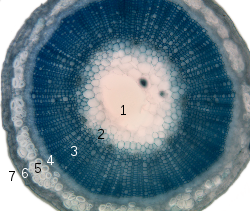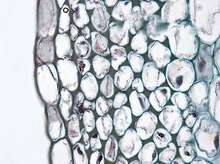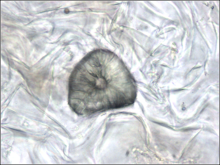- Ground tissue
-
The types of ground tissue found in plants develop from ground tissue meristem and consists of three simple tissues:
- Parenchyma (cells with thin primary walls that retain their protoplasm)
- Collenchyma (cells with thick primary walls that retain their protoplasm)
- Sclerenchyma (cells with lignified secondary walls that have lost their protoplasm at maturity, i.e. are 'dead')
Contents
Parenchyma
Parenchyma is the and versatile ground tissue. It forms, for example, the cortex and pith of stems, the cortex of roots, the mesophyll of leaves, the pulp of fruits, and the endosperm of seeds. Parenchyma cells are living cells and may remain meristematic at maturity, meaning that they are capable of cell division. They have thin but flexible cellulose cell walls, and are generally polyhedral when close-packed, but approximately spherical when isolated from their neighbours. They have large central vacuoles, which allows the cells to store and regulate ions, waste products and water.
Parenchyma cells have a variety of functions:
- In leaves, they form the mesophyll and are responsible for photosynthesis and the exchange of gases[1], parenchyma cells in the mesophyll of leaves are a specialized parenchymatous tissue known as chlorenchyma (parenchyma with chloroplasts).
- Storage of starch, protein, fats and oils and water in roots, tubers (e.g. potato), seed endosperm (e.g. cereals) and cotyledons (e.g. pulses and groundnut)
- Secretion (e.g. hydathodes, nectaries and cells lining the inside of resin ducts)
- Wound repair and the potential for renewed meristematic activity
- Other specialized functions such as aeration (aerenchyma) and support
The form of parenchyma cells varies with their function. The epidermal parenchyma cells of a leaf are barrel shaped in cross section, but have a variety of outline shapes ranging from simple polygons to strongly branched and interlocked shapes resembling the pieces of a jigsaw puzzle, as in the leaves of Arabidopsis thaliana. In the epidermis of higher plants, only the guard cells have chloroplasts. This tissue serves as a barrier wall and protects the internal tissues from injury[1]. In the spongy mesophyll of a leaf, parenchyma cells range from near-spherical and loosely arranged with large intercellular spaces[1] to branched or stellate, mutually interconnected with their neighbours at the ends of the arms to form a three-dimensional network, as in the red kidney bean Phaseolus vulgaris and other mesophytes.[2] These cells, with the epidermal guard cells of the stoma, form a system of air spaces and chambers that regulate the exchange of gases. They usually contain plastids[1].
Collenchyma
The name 'collenchyma' derives from the Greek word κολλα ("kól-la"), meaning "glue", which refers to the thick, glistening appearance of the walls in fresh tissues. Collenchyma tissue is composed of elongated cells with unevenly thickened walls. They provide structural support, particularly in growing shoots and leaves. Collenchyma tissue composes, for example, the resilient strands in stalks of celery. Its growth is strongly affected by mechanical stress upon the plant. The walls of collenchyma in shaken plants (to mimic the effects of wind etc.), may be 40%-100% thicker than those not shaken. The wall is made up of cellulose and pectin.
There are three principal types of collenchyma:
- Angular collenchyma (thickened at intercellular contact points)
- Tangential collenchyma (cells arranged into ordered rows and thickened at the tangential face of the cell wall)
- Lacunar collenchyma (have intercellular space and thickening proximal to the intercellular space)
Collenchyma cells are most often found adjacent to outer growing tissues, the vascular cambium and are known for increasing structural support and integrity.
Sclerenchyma
Sclerenchyma is a supporting tissue in plants. Two groups of sclerenchyma cells exist: fibres and sclereids. Their walls consist of cellulose, hemicellulose and lignin. Sclerenchyma cells are the principal, supporting cells in plant tissues that have ceased elongation. Sclerenchyma fibres are of great economical importance, since they constitute the source material for many fabrics (flax, hemp, jute, ramie).
Unlike the collenchyma, mature sclerenchyma is composed of dead cells with extremely thick cell walls (secondary walls) that make up to 90% of the whole cell volume. The term "sclerenchyma" is derived from the Greek σκληρός ("sklē-rós"), meaning "hard". It is the hard, thick walls that make sclerenchyma cells important strengthening and supporting elements in plant parts that have ceased elongation. The difference between fibres and sclereids is not always clear. Transitions do exist, sometimes even within one and the same plant.
Fibres
Fibres or bast are generally long, slender, so-called prosenchymatous cells, usually occurring in strands or bundles. Such bundles or the totality of a stem's bundles are colloquially called fibres. Their high load-bearing capacity and the ease with which they can be processed has since antiquity made them the source material for a number of things, like ropes, fabrics or mattresses. The fibres of flax (Linum usitatissimum) have been known in Europe and Egypt for more than 3000 years, those of hemp (Cannabis sativa) in China for just as long. These fibres, and those of jute (Corchorus capsularis) and ramie (Boehmeria nivea, a nettle), are extremely soft and elastic and are especially well suited for the processing to textiles. Their principal cell wall material is cellulose.
Contrasting are hard fibres that are mostly found in monocots. Typical examples are the fibres of many Gramineae, Agaves (sisal: Agave sisalana), lilies (Yucca or Phormium tenax), Musa textilis and others. Their cell walls contain, besides cellulose, a high proportion of lignin. The load-bearing capacity of Phormium tenax is as high as 20–25 kg/mm2, the same as that of good steel wire (25 kg/ mm2), but the fibre tears as soon as too great a strain is placed upon it, while the wire distorts and does not tear before a strain of 80 kg/mm2. The thickening of a cell wall has been studied in Linum. Starting at the centre of the fibre are the thickening layers of the secondary wall deposited one after the other. Growth at both tips of the cell leads to simultaneous elongation. During development the layers of secondary material seem like tubes, of which the outer one is always longer and older than the next. After completion of growth the missing parts are supplemented, so that the wall is evenly thickened up to the tips of the fibres.
Fibres usually originate from meristematic tissues. Cambium and procambium are their main centers of production. They are usually associated with the xylem and phloem of the vascular bundles. The fibres of the xylem are always lignified, while those of the phloem are cellulosic. Reliable evidence for the fibre cells' evolutionary origin from tracheids exists. During evolution the strength of the tracheid cell walls was enhanced, the ability to conduct water was lost and the size of the pits reduced. Fibres that do not belong to the xylem are bast (outside the ring of cambium) and such fibres that are arranged in characteristic patterns at different sites of the shoot.
Sclereids
 Long tapered sclereids supporting a leaf edge in Dionysia kossinskyi
Long tapered sclereids supporting a leaf edge in Dionysia kossinskyi
Sclereids are a reduced form of scleremchyma cells with highly thickened, lignified walls.
They are small bundles of sclerenchyma tissue in plants that form durable layers, such as the cores of apples and the gritty texture of pears. Sclereids are much elongated and flexilble with tapered ends.Sclereids are variable in shape. The cells can be isodiametric, prosenchymatic, forked or elaborately branched. They can be grouped into bundles, can form complete tubes located at the periphery or can occur as single cells or small groups of cells within parenchyma tissues. But compared with most fibres, sclereids are relatively short. Characteristic examples are brachysclereids or the stone cells (called stone cells because of their hardness) of pears (Pyrus communis) and quinces (Cydonia oblonga) and those of the shoot of the wax-plant (Hoya carnosa). The cell walls fill nearly all the cell's volume. A layering of the walls and the existence of branched pits is clearly visible. Branched pits such as these are called ramiform pits. The shell of many seeds like those of nuts as well as the stones of drupes like cherries or plums are made up from sclereids.
References
- Moore, Randy; Clark, W. Dennis; and Vodopich, Darrell S. (1998). Botany (3rd ed.). McGraw-Hill. ISBN 0-697-28623-1.
Animals Plants Categories:- Plant anatomy
- Plant cells
- Tissues
Wikimedia Foundation. 2010.




